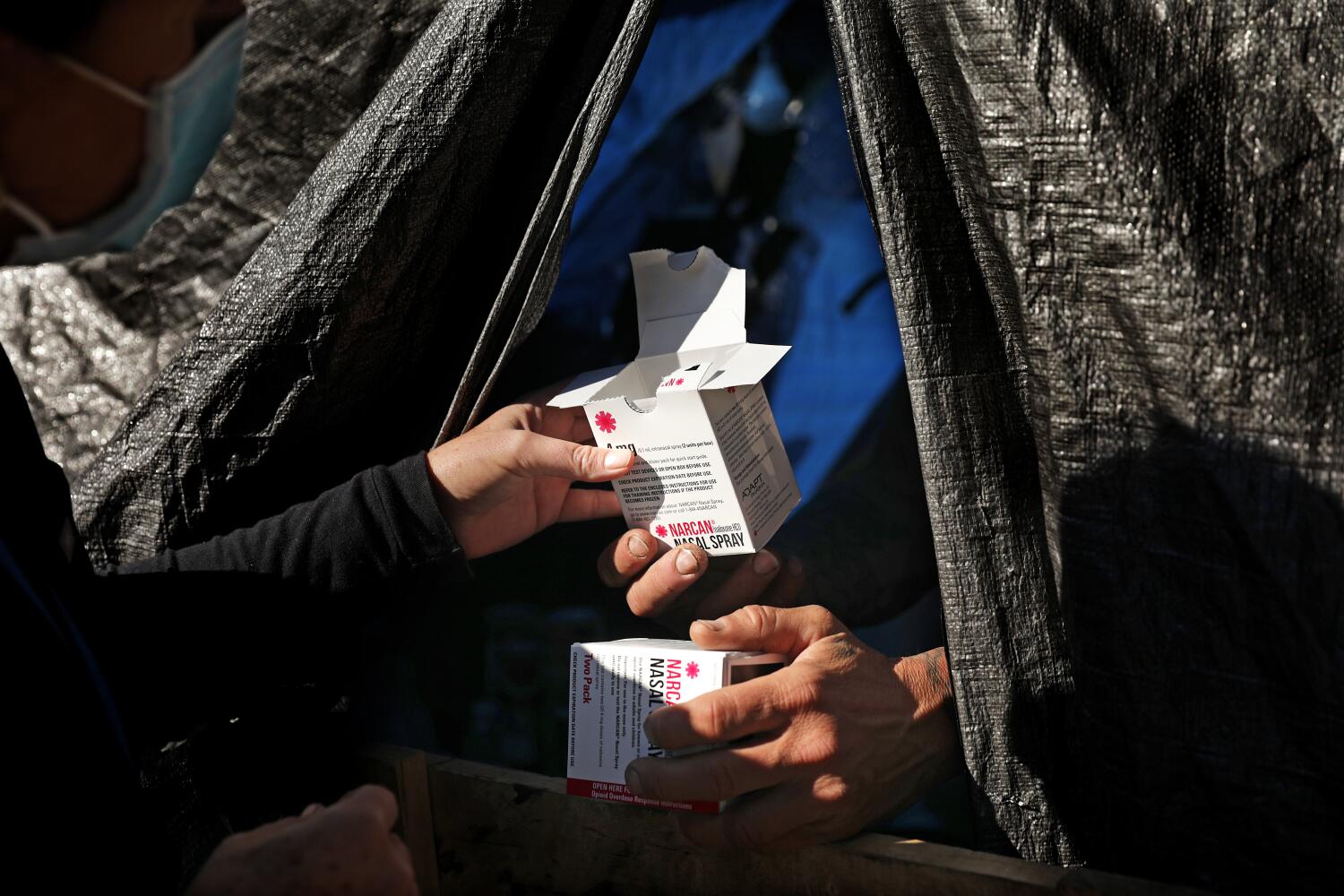
[ad_1]

Year after year, Los Angeles County has seen devastating losses on its streets, as homeless people bedding down in tents, under tarps and on sidewalks have lost their lives to drug overdoses at soaring rates.
Now a newly released report shows the death rate from overdoses stopped rising among unhoused people in the county in 2022 — the same year L.A. County was stepping up its efforts to save lives.
Public health officials welcomed the news as a glint of hope, but cautioned it is too soon to say if the numbers are headed for a lasting downturn. They pointed to a county push to dramatically ramp up the distribution of naloxone — a medicine that bystanders can use to stop opioid overdoses — as a likely factor.
In their report, county officials touted a “near doubling” that year in the reported number of overdoses that were thwarted with naloxone, based on figures provided by a county program. The lifesaving medicine is commonly sold as a nasal spray under the brand name Narcan.
Two years ago in North Hollywood, Manny Placeres told The Times he had revived people seven times using Narcan that had been provided to him by a county team, honing his technique with time.
“As they’re knocking on heaven’s door, I pull them back,” Placeres said.
The L.A. County Department of Health Services has handed out Narcan at homeless encampments, given it to community groups and county agencies and set up vending machines to dispense it for free to people leaving county jails.
As of February, the health services department said it had distributed more than 600,000 doses of naloxone since launching its initiative, resulting in more than 25,000 overdoses being stopped. Community groups and syringe programs have bolstered such efforts by handing out their own supplies of free naloxone provided by the state.
Dr. Gary Tsai, director of the public health department’s substance abuse prevention and control bureau, said that after years of alarming increases, “it is encouraging to see a slowing of this leading cause of death for people experiencing homelessness.”
“Efforts to increase access to naloxone and overdose prevention services have undoubtedly helped to bend this curve and provide a blueprint for reducing drug-related fatalities in this very high-risk population,” he said in a statement.
County officials said such efforts had also helped stabilize the death rate for homeless people overall after years of disturbing growth. As deadly overdoses stopped surging and COVID-19 deaths plunged, the overall mortality rate among unhoused people in L.A. County began to level off, the report found.
But homeless people remained far more likely than other county residents to die in a range of ways, including overdoses, traffic collisions, heart disease and homicide.
Their death rate overall was nearly four times higher than that of the broader population — a gap that has widened over time, public health officials found. And although it may have finally hit a plateau, the mortality rate for homeless people in L.A. County was still 60% higher than it had been three years earlier.
“This report highlights the continued need for concerted efforts to reduce the disproportionate burden of mortality among this vulnerable population,” L.A. County Public Health Director Barbara Ferrer said in a statement.
The county report also pointed out some alarming variations in the overall trends in L.A. County: For Black people who were unhoused, for instance, the rate of overdose deaths continued to rise significantly in 2022.
The rate of fatal overdoses also kept rising among homeless people in their 20s and 40s, the report found. That was offset by dropping rates among older people, but the report raised a grim possibility: After so many deadly years, “there may now be fewer surviving fentanyl and other opioid users over 50.”
Narcan can stop overdoses from opioids such as fentanyl, a powerful synthetic drug that has been involved in a rising share of overdose deaths among homeless people in L.A. County.
But fentanyl has not been the only threat: Roughly two-thirds of deadly overdoses among unhoused people involved more than one drug. Among the most commonly mingled were fentanyl and methamphetamine, a combination involved in nearly half of overdose deaths among homeless people in the county in 2022, according to the new report.
L.A. County public health officials called for a number of steps to bring down deaths among unhoused people, including expanding housing options so that people who use drugs will not lose their housing as a result; handing out more naloxone and test strips that detect fentanyl; and expanding preventative care for people who are homeless.
[ad_2]
Source link